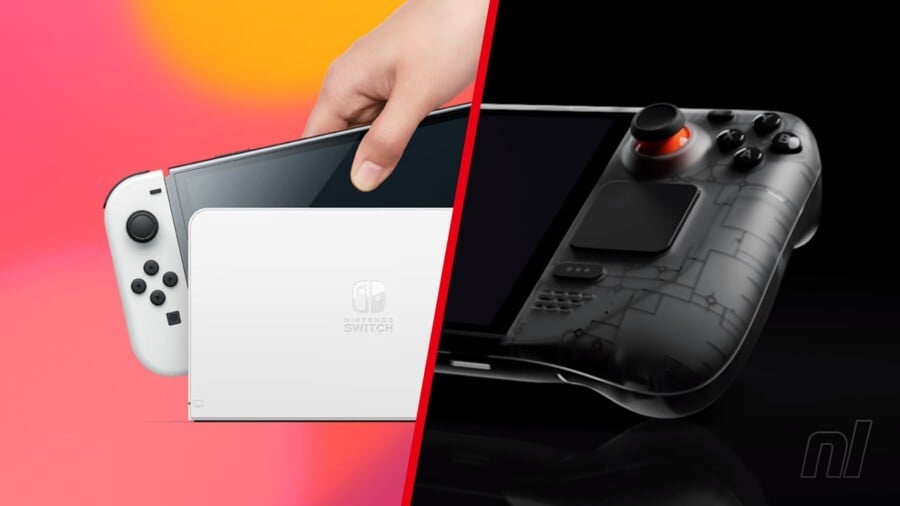On this page: Switch OLED Vs. Steam Deck OLED - Full Tech Specs, Nintendo / Valve Handheld Comparison
1. Nintendo Switch OLED / Steam Deck OLED Technical Specifications Comparison 1.1. TL;DR 1.2. The Specs 1.3. Steam Deck OLED Upgrades Over The Standard Steam Deck LCD 2. Switch OLED Vs. Steam Deck OLED Price: How Much Do They Cost? 3. Switch OLED Vs. Steam Deck OLED - Which Is Better? Valve Nintendo Switch OLED / Steam Deck OLED Technical Specifications Comparison
The chart below presents the full tech specs for Nintendo Switch OLED (as detailed on Nintendo's official website ) and Steam Deck OLED (as covered on Valve's website ).
TL;DR Steam Deck OLED is considerably bigger, heavier, and more expensive than Nintendo Switch OLED with a commensurate performance increase to match, has a slightly bigger screen (which supports HDR), much larger internal storage , and slightly better battery life depending on the software being used.
Both consoles can connect to TVs or monitors via HDMI , although you'll need to pay extra for a Steam Deck Docking Station (Switch is sold with a dock included).
The Specs
Nintendo Switch (OLED Model)
Valve Steam Deck OLED
Size
4 inches high, 9.5 inches long, and 0.55 inches deep (with Joy-Con attached)
298mm x 117mm x 49mm (11.7 inches x 4.6 inches x 1.9 inches)
Weight
Approximately .71 lbs / 322 grams
Approx. 1.41 lbs / 640 grams
Screen
Multi-touch capacitive touch screen / 7-inch OLED screen / 1280x720
High-performance touch / 7.4-inch
CPU/GPU
NVIDIA Custom Tegra processor
6 nm AMD APU
Storage
64 GB
Steam Deck 512GB NVMe SSDBoth include high-speed microSD card slot
Wireless / LAN
Wi-Fi (IEEE 802.11 a/b/g/n/ac compliant) / Bluetooth 4.1
Tri-band Wi-Fi 6E radio, 2.4GHz, 5GHz, and 6GHz 2 x 2 MIMO, IEEE 802.11a/b/g/n/ac/ax
Bluetooth 5.3 (support for controllers, accessories and audio)
Video output
Up to 1080p via HDMI in TV mode
1280 x 800
up to 90Hz
Audio output
Compatible with 5.1ch Linear PCM output
Multichannel audio via DisplayPort over USB-C, standard USB-C, or Bluetooth 5.3
Speakers
Stereo
Stereo with embedded DSP for an immersive listening experience
USB connector
USB Type-C
PD3.0 Type C power supply, 45W
Headphone/mic jack
3.5mm 4-pole stereo (CTIA standard)
3.5mm stereo headphone / headset jack
Dual microphone array
Game card slot
Nintendo Switch game cards
N/A
microSD card slot
Compatible with microSD, microSDHC, and microSDXC memory cards
UHS-I supports SD, SDXC and SDHC
Sensor
Accelerometer, gyroscope, and brightness sensor
6-Axis IMUDual ambient light sensor ALS
Operating environment
41-95 degrees F / 20-80% humidity
Not provided
Internal battery
Lithium-ion battery / 4310mAh
50Whr battery
Battery life
Approximately 4.5 - 9 hoursThe Legend of Zelda: Breath of the Wild .
3-12 hours of gameplay
Charging time
Approximately 3 hours
"20% to 80% in as little as 45 minutes"
Valve Steam Deck OLED Upgrades Over The Standard Steam Deck LCD
In addition to the OLED screen, the latest Steam Deck has various other upgrades over its predecessor, including improved battery life.
If you're wondering how the Steam Deck OLED compares to the regular model, here's a list of additional updates over the standard Steam Deck from Valve's website :
General
WiFi/Bluetooth
Software
Switch OLED Vs. Steam Deck OLED Price: How Much Do They Cost?
Switch OLED costs $349.99.
Steam Deck OLED prices start at $549 for the 512GB version, rising to $649 for the 1TB variant.
Steam Deck OLED is $200-300 more expensive than Switch OLED, depending on the model you want.
Switch OLED Vs. Steam Deck OLED - Which Is Better?
When it comes to direct comparisons between Switch OLED and Steam Deck OLED, we're really comparing apples and oranges here.
Switch OLED is a Nintendo device which plays Nintendo games. It's built on a mobile chipset developed in the mid-2010s, with commensurate technological weaknesses compared to hardware developed in the interim. It's designed to appeal to a broad spectrum of players of all ages and has a large library of games , many of them exclusive first-party games from Nintendo itself.
Valve , Zion Grassl / Nintendo LifeSteam Deck OLED is a handheld PC primarily designed to appeal to PC gamers with substantial Steam libraries and PC enthusiasts looking for a convenient way to take their games on the go. The hardware is both larger and more recently developed (and more expensive), meaning it offers substantial performance upgrades over Switch.
Both systems offer large libraries and excellent gameplay experiences and are superficially similar devices. If you have to choose between one and the other, it really comes down to how badly you need the best performance available in a portable gaming device vs. how madly you need access to Nintendo's stable of exclusive games, including Mario , Zelda , Pokémon , and many other popular series which aren't available to buy on non-Nintendo hardware.
